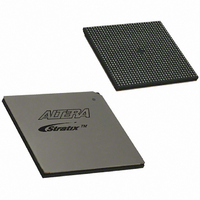EP1S80B956C7N Altera, EP1S80B956C7N Datasheet - Page 331

EP1S80B956C7N
Manufacturer Part Number
EP1S80B956C7N
Description
IC STRATIX FPGA 80K LE 956-BGA
Manufacturer
Altera
Series
Stratix®r
Datasheet
1.EP1S10F484I6N.pdf
(864 pages)
Specifications of EP1S80B956C7N
Number Of Logic Elements/cells
79040
Number Of Labs/clbs
7904
Total Ram Bits
7427520
Number Of I /o
683
Voltage - Supply
1.425 V ~ 1.575 V
Mounting Type
Surface Mount
Operating Temperature
0°C ~ 85°C
Package / Case
956-BGA
Lead Free Status / RoHS Status
Lead free / RoHS Compliant
Number Of Gates
-
Available stocks
Company
Part Number
Manufacturer
Quantity
Price
- Current page: 331 of 864
- Download datasheet (11Mb)
Figure 1–10. High-Bandwidth PLL Lock Time
Altera Corporation
July 2005
Frequency (MHz)
160
155
150
145
140
135
130
125
120
0
0.5
A high-bandwidth PLL may benefit a system with two cascaded PLLs. If
the first PLL uses spread spectrum (as user-induced jitter), the second
PLL needs a high bandwidth so it can track the jitter that is feeding it. A
low-bandwidth PLL may, in this case, lose lock due to the spread
spectrum-induced jitter on the input clock.
A low-bandwidth PLL may benefit a system using clock switchover.
When the clock switchover happens, the PLL input temporarily stops. A
low-bandwidth PLL would react more slowly to changes to its input
clock and take longer to drift to a lower frequency (caused by the input
stopping) than a high-bandwidth PLL.
demonstrate this property.
The two plots show the effects of clock switchover with a low- or high-
bandwidth PLL. When the clock switchover happens, the output of the
low-bandwidth PLL (see
slower than the high-bandwidth PLL output (see
1.0
1.5
2.0
General-Purpose PLLs in Stratix & Stratix GX Devices
Figure
Time (μs)
2.5
1–11) drifts to lower frequency much
3.0
Stratix Device Handbook, Volume 2
Figures 1–11
3.5
Lock Time = 4 μs
Figures
and
4.0
1–12
1–12).
4.5
1–21
5.0
Related parts for EP1S80B956C7N
Image
Part Number
Description
Manufacturer
Datasheet
Request
R

Part Number:
Description:
CYCLONE II STARTER KIT EP2C20N
Manufacturer:
Altera
Datasheet:

Part Number:
Description:
CPLD, EP610 Family, ECMOS Process, 300 Gates, 16 Macro Cells, 16 Reg., 16 User I/Os, 5V Supply, 35 Speed Grade, 24DIP
Manufacturer:
Altera Corporation
Datasheet:

Part Number:
Description:
CPLD, EP610 Family, ECMOS Process, 300 Gates, 16 Macro Cells, 16 Reg., 16 User I/Os, 5V Supply, 15 Speed Grade, 24DIP
Manufacturer:
Altera Corporation
Datasheet:

Part Number:
Description:
Manufacturer:
Altera Corporation
Datasheet:

Part Number:
Description:
CPLD, EP610 Family, ECMOS Process, 300 Gates, 16 Macro Cells, 16 Reg., 16 User I/Os, 5V Supply, 30 Speed Grade, 24DIP
Manufacturer:
Altera Corporation
Datasheet:

Part Number:
Description:
High-performance, low-power erasable programmable logic devices with 8 macrocells, 10ns
Manufacturer:
Altera Corporation
Datasheet:

Part Number:
Description:
High-performance, low-power erasable programmable logic devices with 8 macrocells, 7ns
Manufacturer:
Altera Corporation
Datasheet:

Part Number:
Description:
Classic EPLD
Manufacturer:
Altera Corporation
Datasheet:

Part Number:
Description:
High-performance, low-power erasable programmable logic devices with 8 macrocells, 10ns
Manufacturer:
Altera Corporation
Datasheet:

Part Number:
Description:
Manufacturer:
Altera Corporation
Datasheet:

Part Number:
Description:
Manufacturer:
Altera Corporation
Datasheet:

Part Number:
Description:
Manufacturer:
Altera Corporation
Datasheet:

Part Number:
Description:
CPLD, EP610 Family, ECMOS Process, 300 Gates, 16 Macro Cells, 16 Reg., 16 User I/Os, 5V Supply, 25 Speed Grade, 24DIP
Manufacturer:
Altera Corporation
Datasheet:












